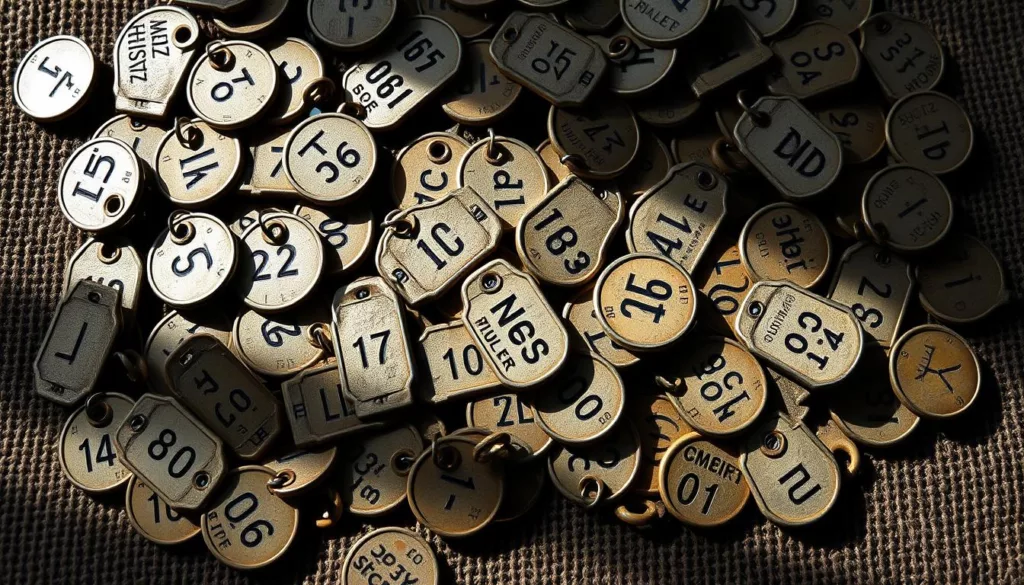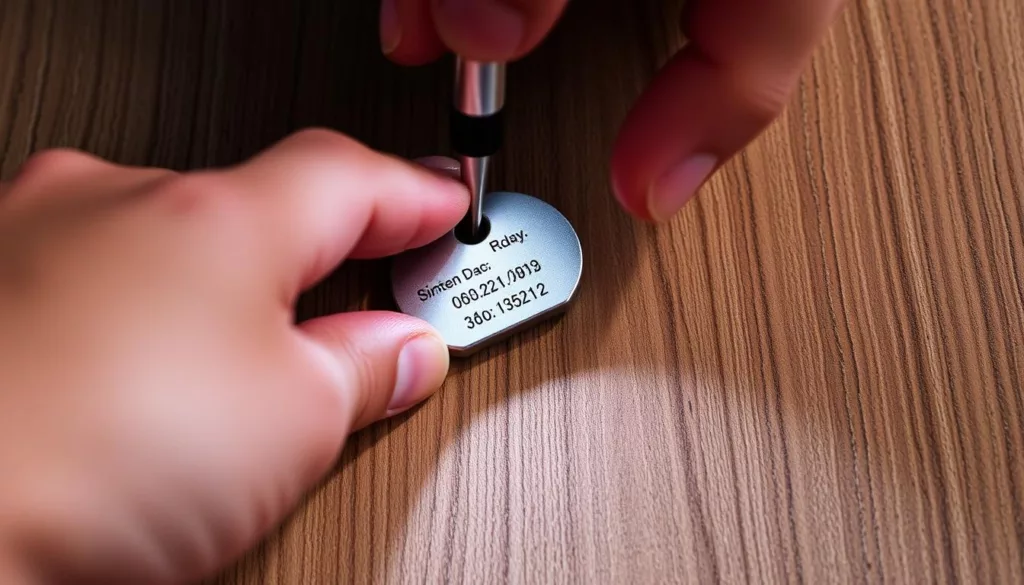A dog ID tag is crucial for your pet’s safety. Knowing what not to put on it is just as important as knowing what to include. A bad ID tag can put your pet in danger and worry you. It’s important to avoid details that could harm your pet’s privacy or attract unwanted attention.
This guide will help you avoid common mistakes. It ensures your dog’s ID tag works as it should. It also highlights the quality of brands like UC Tag.
Key Takeaways
- Avoid including your full name and address.
- Do not list overly detailed contact information.
- Exclude nicknames or aliases that may confuse.
- Refrain from mentioning long medical conditions or excessive care instructions.
- Skip unnecessary items such as microchip information.
- Do not use misleading labels regarding your dog’s behavior.
- Consider the readability of the tag to avoid overloading with details.
Understanding the Importance of Dog ID Tags
Dog ID tags are crucial for pet safety. They help find lost animals quickly. These tags have vital contact info, making it easier for pets to be returned home.
Every pet owner should know how important these tags are. They are key to keeping pets safe and happy.
Why Dog ID Tags Matter
Pets can easily get lost in today’s world. Dog ID tags are more than just a fashion statement. They are a lifeline that connects pets to their owners.
Good ID tags have important details. They help pets get back home safely. This is vital for their safety and happiness.
Legal Requirements for ID Tags
Many places have laws about ID tags for pets. These laws vary, but most require tags with the owner’s contact info. Not following these laws can lead to fines or even more serious penalties.
Knowing these laws helps keep pets safe. It shows community responsibility and care for pets’ well-being.
| State | Legal Requirement for ID Tags | Penalties for Non-Compliance |
|---|---|---|
| California | Must wear ID tags at all times | Fines up to $500 |
| New York | Identification tags required for all dogs | Fines and potential removal of the pet |
| Texas | Mandatory ID tags for pets in public spaces | Fines of $200 for first offense |
Personal Information to Avoid
When making a dog ID tag, keeping personal info private is key. Some details to skip can make your dog tag safer and protect you from harm. Knowing what not to include helps avoid bad situations or misuse of your info.
Your Full Name and Address
Putting your full name and address on the tag is a privacy risk. It lets strangers find your home, which can be dangerous. Keeping this info off the tag helps keep you and your home safe.
Overly Detailed Contact Information
Stick to one monitored phone number or email for contact. Too much info, like many phone numbers or work addresses, can be risky. Choose simple ways for someone to reach you, keeping your identity safe while still helping find your pet.
Confusing Information to Exclude
When making a dog ID tag, it’s important to be clear, not sentimental. Nicknames or aliases might seem cute, but they can confuse people. A simple, recognizable name is better for finding a lost pet.
Nicknames or Aliases
Using nicknames might feel loving, but it can confuse others. If someone finds your dog, they might not know who to call. Stick with the dog’s real name for a better chance of being reunited.
Irrelevant Details
Adding extra stuff like breed or personality traits can mess up the tag’s purpose. These mistakes can make it hard to find the owner’s contact info. Keep it simple with just the basics.
| Information Type | Recommended Approach | Common Mistakes |
|---|---|---|
| Dog’s Name | Use the full, recognized name | Include a nickname or alias |
| Contact Number | Provide a mobile number | Include work or irrelevant numbers |
| Address | Only essential information | Overloading with details |
| Medical Information | Keep it minimal | Listing extensive conditions |
Health-Related Warnings and Limitations
When making dog ID tags, it’s key to keep health warnings simple. Too much info can confuse people, which is bad in emergencies. It’s best to share the most important health details clearly.
Long Medical Conditions
Long medical descriptions don’t fit well on tags. They make it hard to read fast in emergencies. Instead, vets can share important health info with clinics.
Emergency teams can quickly get health details from vets. This way, ID tags stay easy to read.
Excessive Instructions for Care
Too many care instructions on tags can be overwhelming. It’s better to keep it simple and direct. For more details, QR codes can link to health records.
This approach keeps info handy without cluttering the tag. It makes sure the tag is easy to read.
Unnecessary Items to Skip
When making a dog ID tag, it’s important to skip unnecessary info. Details like microchip numbers and social media handles can confuse people. They don’t add much value and might even risk your pet’s safety.
Microchip Information
Microchip details are often not needed on dog tags. A microchip has a database with the owner’s contact info. People looking for a lost pet will check for a microchip anyway.
Adding microchip info to the tag just takes up space. It’s better to use that space for more important details.
Social Media Handles
Putting social media handles on a dog ID tag is a privacy risk. Sharing online is fun, but it’s not safe on an ID tag. It could attract unwanted attention and harm your privacy.
It’s safer to stick to basic contact info. This keeps your pet’s identity safe and professional.
Misleading Statements to Avoid
When it comes to dog ID tags, misleading statements can cause big problems. Labels that suggest a dog’s mood or behavior can be harmful. These descriptions often lead to confusion.
A label like “friendly” might encourage too much interaction. On the other hand, “aggressive” could make people fear or defend themselves. It’s important to use neutral language to keep everyone safe.
“Friendly” or “Aggressive” Labels
Labels that describe a dog’s personality can be misleading. What one person sees as “friendly,” another might not. This can be risky for the dog and those trying to help.
Using neutral phrases like “pet may be scared” can help. It encourages safer interactions.
Assumptions About Behavior
It’s important not to assume a dog’s behavior based on an ID tag. Misleading statements can lead to dangerous situations. Using vague descriptions helps avoid these problems.
By removing specific behavior descriptions, pet owners can communicate more clearly. This makes ID tags safer for everyone involved.
Emergency Contact Information Considerations
When making pet ID tags, emergency contact details are key. They help get a quick response. It’s important to pick the right contact number for pet safety. Work numbers might not be the best choice.
Busy work places can make it hard to get in touch. This can slow down finding a lost pet. Choosing personal contacts can help reunite pets faster.
Avoid Using Work Numbers
Work numbers can be a problem when you need to act fast. If your pet goes missing, a work number might not work. Family or trusted friends are better choices for emergency contacts.
Using a personal phone number means someone will be there to help right away. This makes pet safety better.
Personal vs. Professional Contacts
It’s important to know the difference between personal and professional contacts. Personal contacts usually respond faster. Here are some tips for choosing the right emergency contacts:
- Choose someone who is available any time.
- Make sure they know your pet well and understand the urgency.
- Think about having more than one personal contact for extra safety.
What is Too Much Information?
When it comes to dog ID tags, finding the right balance is key. Too much info can confuse people and make the tag less useful. It’s important to keep the information clear and to the point.
This way, anyone who finds your dog can quickly get the important details. This helps keep your pet safe and sound.
Overloading with Details
Too many details can make the tag hard to read. Stick to the basics like your dog’s name and a main contact number. Leave out the extra stuff.
This makes it easier to find the key info when it matters most.
Readability Issues
It’s crucial that dog ID tags are easy to read. Too much info can make the tag look messy. Choose fonts and sizes that are clear and simple.
This way, anyone can quickly understand the information. A well-organized tag helps keep your pet safe.
Common Myths Surrounding ID Tags
It’s important for pet owners to know the truth about dog ID tags. This section will clear up common myths about privacy and legal issues. Knowing the facts can help keep pets safe and sound.
Misconceptions About Privacy
Many pet owners worry about privacy when it comes to ID tags. They think showing personal info makes them a target for thieves. But, ID tags are key to getting pets back home fast.
They help connect lost pets with their owners quickly. The benefits of ID tags far outweigh any privacy concerns.
Legal Myths About Lost Pets
There are also myths about lost pets and the law. Some think pets don’t need ID to be protected. But, many places require ID to ensure pets are returned.
Without ID, finding a lost pet is much harder. It’s crucial for owners to know the laws about pet ID in their area.
Creative Designs: What Not to Include
When picking out a dog tag, it’s key to skip things that might mess up its purpose. Creative touches can make the tag look good, but they shouldn’t hide the important stuff. It’s all about finding a balance between looks and function.
Distracting Colors or Patterns
Too bright colors or busy patterns can make the tag hard to read. A tag that blends in or is hard to spot can cause trouble. Stick with simple, clear colors to help your dog get noticed fast.
Information Hidden by Design
Don’t let fancy designs hide the important stuff. For example, fancy text can look cool but might be hard to see. Make sure the design doesn’t get in the way of reading the tag’s details.
Alternatives to Dog ID Tags
Pet owners looking for new ways to identify their pets can find many options. These include collar embroidery and GPS tracking devices. Each has its own benefits and things to consider, fitting different lifestyles.
Collar Embroidery Options
Collar embroidery is a stylish and practical choice. It lets you weave your pet’s info right into their collar. This way, you don’t have to worry about losing a tag.
Collar embroidery can show your pet’s name and your contact number. It’s a simple way for someone to find you if they find your pet.
- Advantages: Durable, permanent, and looks good.
- Disadvantages: Can’t hold much info and might fade.
GPS Tracking Devices
GPS pet trackers are a modern choice. They let you track your pet’s location in real-time. This gives you peace of mind, more than just a tag can.
These devices also track your pet’s activity and send alerts when they leave a certain area. It’s a step up from traditional ID tags.
- Advantages: Tracks your pet in real-time and keeps them safe.
- Disadvantages: Needs to be charged and might cost extra for extra features.
Final Thoughts on Dog ID Tags
Keeping dog ID tags up to date is very important. Pet owners should update these tags after any big changes. This includes moving, changing phone numbers, or switching owners. It’s a key responsibility to help lost pets find their way back home.
Importance of Updating Information
Keeping ID details current helps avoid confusion in emergencies. Without the right contact info, a lost dog might not be found. Pet owners need to stay on top of their dog’s info to prevent this.
Regularly Assessing Your Dog’s Safety
Looking at more than just ID tags is part of a dog safety check. It’s about the pet’s surroundings, who they meet, and their health too. Regular checks can spot dangers and help keep your dog safe.
Working with experts, like those from UC Tag, can make your dog’s safety even better. They help make sure your dog’s safety meets high standards.
Conclusion: Keeping Your Dog Safe with Proper ID Tags
As we’ve seen, the right dog ID tags are crucial. They should have the basics but not too much. This makes sure your dog is safe and easy to find if lost. Knowing what not to include helps keep your pet’s info safe and private.
A good dog ID tag has the right info but leaves out the unnecessary. It should have your contact details but not your dog’s full name or complex health issues. This way, if someone finds your dog, they know who to call. Working with experts like UC Tag helps make sure these tags are just right for your pet.
In short, using these tips helps keep your pet safe and your info private. It also increases the chances of being reunited with your lost pet. Making thoughtful choices about your dog’s ID tags is key to being a responsible pet owner.
FAQ
What information should I include on my dog ID tag?
Include your phone number or a monitored email address. This makes it easy for people to reach you. Don’t put too much personal info to keep your pet’s privacy safe.
Why is it important to have a dog ID tag?
ID tags help find lost pets quickly. They are also often required by law. This keeps your pet safe and happy.
What personal information should I avoid on a dog ID tag?
Don’t list your full name, home address, or too much contact info. It could risk your privacy and lead to identity theft.
Can I use nicknames or aliases on my dog’s ID tag?
It’s better to use a name that’s easy to recognize. Avoid nicknames or aliases that might confuse people.
Is it advisable to include medical conditions on the dog ID tag?
Don’t list too many medical conditions or care instructions. It can overwhelm people who find your pet. Instead, use a QR code for quick access to your pet’s health records.
Should I include microchip information on the ID tag?
No, it’s not needed. Microchip info is already linked to you. The tag should just have your contact info.
What statements should be avoided regarding my dog’s behavior?
Avoid saying your dog is “friendly” or “aggressive.” It can cause confusion. Use neutral language to avoid misunderstandings.
Is it wise to use work numbers as emergency contact information?
Use a personal phone number instead of a work number. This ensures you can be reached quickly for your pet’s safety.
What should I consider about readability when designing a dog ID tag?
Keep the tag simple and clear. Too much info can make it hard to read. Use easy-to-read fonts for anyone to understand.
Are there common myths regarding ID tags that I should be aware of?
Yes, one myth is that ID tags are a privacy risk. But they’re important for pet safety and legal reasons.
What should I not include in the design of a dog ID tag?
Avoid colors and patterns that might hide important info. Make sure the design is clear and easy to read.
What alternatives are available to traditional dog ID tags?
Consider collar embroidery or GPS tracking devices. They offer extra security and can help find your pet.
How often should I update the information on my dog’s ID tag?
Update the tag often, like after moving or changing contact info. This keeps your pet safe and identifiable.





